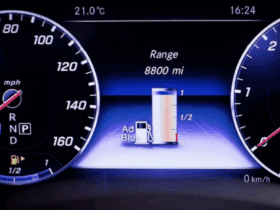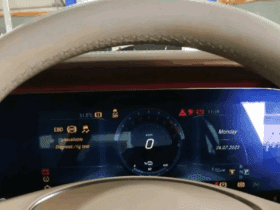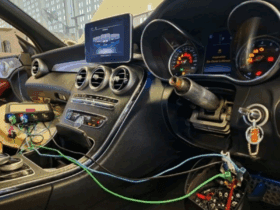Table of Contents
Mercedes-Benz EQ Cooling System Fault – Step-by-Step Case Study & Repair Guide
Vehicle: Mercedes-Benz EQ (EQS, EQS SUV, EQE, EQE SUV – depending on platform and part compatibility)
Customer Complaint: Yellow warning on cluster – “Cooling system fault. Operating energy input reduced. Service required.”
Fault Code: B3A0077 – Regulation valve in battery refrigerant circuit stuck open.
Main Component: Expansion valve Y140/1 in the refrigerant circuit.
In this case study, we’ll explore a real-life diagnosis and repair process for a Cooling System Fault in a Mercedes-Benz EQ, highlighting a common failure point: the battery cooling system expansion valve (component Y140/1). By the end, you’ll understand how to identify the issue, verify the cause, and resolve it step-by-step.
Step 1: Understanding the Cooling System Fault
The Mercedes EQ thermal management system controls temperatures for:
- – High-voltage battery
- – Electric motor
- – Power electronics
If the system malfunctions, the vehicle may:
- – Reduce power to protect components.
- – Enter limp/reduced output mode.
- – In severe cases, shut down to prevent battery damage.
In this case: a diagnostic scan revealed the fault code B3A0077, which points to the regulation valve in the refrigerant circuit for battery cooling. The description indicates that the valve is stuck open and cannot achieve the commanded position. This component coded Y140/1 is responsible for regulating the flow of refrigerant through the battery cooling circuit.


Symptoms & Likely Causes
| Symptom | Likely Cause | Related Component |
|---|---|---|
| “Cooling system fault” warning | Expansion valve stuck open | Y140/1 |
| Reduced energy input | Restricted battery cooling | Battery cooling circuit |
| Inconsistent cooling | Poor refrigerant flow | Expansion valve |
Step 2: Root Cause – Faulty Y140/1 Expansion Valve
Upon deeper investigation, the culprit was the expansion valve Y140/1, a critical component that modulates the refrigerant flow based on thermal demand. This valve is electrically actuated and prone to mechanical sticking over time.
The issue in our scenario stems from an outdated part version. Mercedes-Benz issued an updated part with improved reliability.
Compare the Part Number:
- – Older Version (Needs Replacement): A 297 830 54 03
- – Updated Version (Reliable): A 297 830 89 03
If your EQ still has the old version, replacement is the permanent fix.
Step 3: Tools & Equipment Required
| Tool | Purpose |
|---|---|
| Mercedes XENTRY | Diagnostics, coolant fill/purge mode |
| Refrigerant recovery machine | Remove A/C refrigerant safely |
| Coolant drain system | Drain battery coolant |
| Torque wrench | Secure fittings to OEM specs |
| Safety gloves & glasses | Technician safety |
| Updated Y140/1 valve | P/N: A 297 830 89 03 |
| OEM coolant | Mercedes-approved formula |
Step 4: Step-by-Step Repair Procedure
To replace the faulty expansion valve and fix the Cooling System Fault in your Mercedes EQ, follow these steps carefully:
| Step | Action | Key Notes |
|---|---|---|
| 1 | Drain A/C refrigerant | Use certified recovery machine (More details bellow) |
| 2 | Drain battery coolant | Ensure system is depressurized (More details bellow) |
| 3 | Remove old Y140/1 | Disconnect electrical & refrigerant lines (More details bellow) |
| 4 | Install updated valve | Torque to OEM specs (More details bellow) |
| 5 | Refill coolant | Use MB-approved coolant (More details bellow) |
| 6 | Run purge routine | Remove trapped air (More details bellow) |
| 7 | Clear fault codes | Verify repair with XENTRY (More details bellow) |
1. Drain the Air Conditioner
Before working on the refrigerant circuit:
- – Connect a certified recovery machine.
- – Recover all refrigerant from the A/C system in compliance with local environmental regulations.

2. Drain the Coolant
- – Safely open the coolant drain plug.
- – Collect the coolant in a clean container for reuse if not contaminated.
- – Be sure the coolant circuit is fully depressurized to avoid injury.
3. Remove the Faulty Y140/1 Expansion Valve
- – Locate the Y140/1 valve in the battery cooling loop.
- – Disconnect the electrical connector.
- – Use appropriate tools to remove the refrigerant and mounting connections.
- – Carefully remove the expansion valve.

4. Install the New Expansion Valve
- – Fit the updated A 297 830 89 03 valve.
- – Torque all fittings to OEM specifications.
- – Reconnect the electrical harness.


Step 5: Refill and Bleed the Cooling System
After replacing the expansion valve, it’s essential to restore and purge the coolant circuit properly to avoid residual air that could cause future cooling problems.
Steps to Follow:
1. Activate the Coolant Circuit Filling Mode
- – Using the diagnostic tool, enter the special coolant fill mode to allow proper circulation and venting.

2. Pour in the Coolant
- – Add Mercedes-Benz approved coolant into the reservoir.
- – Observe the fill level and ensure it stays between MIN and MAX.
3. Disable the Coolant Circuit Fill Mode
- – Exit the fill mode via the scan tool once the system has been adequately filled.
4. Start the Coolant Circuit Purge Routine
- – Launch the purge routine using your scan tool.
- – This process eliminates trapped air and ensures proper coolant flow through all components.

5. Check Coolant Level
- – Once the purge routine finishes, verify the coolant level again.
- – Top off if necessary to meet system specifications.
6. Install the Lower Engine Compartment Trim
- – Reattach all panels and trims removed for access.
- – Ensure all clips and fasteners are secured to avoid rattles.
Step 6: Post-Repair Verification
- – Clear fault codes using XENTRY.
- – Re-scan to verify no new or pending codes exist.
- – Start the vehicle and monitor system operation for 10–15 minutes.
- – Confirm the Cooling System Fault message no longer appears.
- – Perform a short road test if needed.
Why This Cooling System Fault Is Common in EQ Models
Early Mercedes EQ models often shipped with A 297 830 54 03 prone to sticking and failure.
Mercedes later introduced A 297 830 89 03, which significantly improved durability.
Mercedes-Benz issued a silent revision to address this issue, but many vehicles still on the road have the older valve. If you’re an owner or technician working on Mercedes EQ models, this case highlights the importance of checking part revisions when dealing with battery or thermal system faults.
Prevention Tips
| Action | Interval |
|---|---|
| Check coolant & A/C function | Every 6 months |
| Verify expansion valve part number | At each thermal system service |
| Replace outdated valve | Immediately if fault appears |
Conclusion
The Cooling System Fault warning in a Mercedes-Benz EQ shouldn’t be ignored. It directly impacts the performance and longevity of the high-voltage battery. In our case study, we identified a faulty expansion valve Y140/1 as the root cause, verified by fault code B3A0077. Replacing the outdated part with the newer revision and properly restoring the system resolved the issue completely.
FAQ – Mercedes EQ Cooling System Fault
Q: What does the “Cooling System Fault” warning mean?
A: It means the high-voltage battery’s thermal management isn’t working correctly, which can limit performance and power delivery.
Q: What is fault code B3A0077?
A: It indicates the battery cooling expansion valve (Y140/1) is stuck open.
Q: Which part should be replaced?
A: Replace Y140/1 if it’s the older A 297 830 54 03 with the updated A 297 830 89 03.
Q: Can I keep driving with this fault?
A: Not recommended battery overheating risks long-term damage.
Q: How is it fixed?
A: Replace the outdated valve, drain/refill both refrigerant & coolant systems, purge air, and recheck codes.
More Mercedes Cooling System Resources
Want to explore more causes, symptoms, and repair tips for coolant leaks, overheating, and contamination?
Learn more about Mercedes cooling system faults in our full Cooling System Guide.
Author Box
Author: Mercedes Expert – Certified EV & Hybrid Diagnostics Specialist with over 12 years in Mercedes-Benz service center. Specializes in battery cooling systems, thermal management, and high-voltage safety procedures.










Leave a Reply